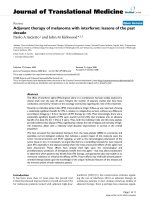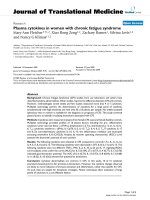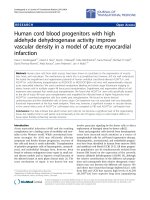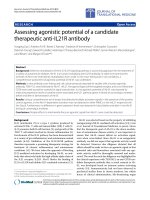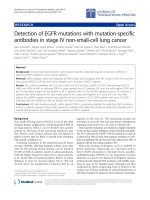Báo cáo hóa học: " Riemann-Liouville fractional integro-differential equations with fractional nonlocal integral boundary conditions" pptx
Bạn đang xem bản rút gọn của tài liệu. Xem và tải ngay bản đầy đủ của tài liệu tại đây (275.82 KB, 9 trang )
RESEARC H Open Access
Riemann-Liouville fractional integro-differential
equations with fractional nonlocal integral
boundary conditions
Bashir Ahmad
1*
and Juan J Nieto
1,2
* Correspondence:
1
Department of Mathematics,
Faculty of Science, King Abdulaziz
University P.O. Box 80203, Jeddah
21589, Saudi Arabia
Full list of author information is
available at the end of the article
Abstract
This article investigates a boundary value problem of Riemann-Liouville fractional
integro-differential equations with fractional nonlocal integral boundary conditions.
Some new existence results are obtained by applying standard fixed point theorems.
2010 Mathematics Subject Classification: 26A33; 34A34; 34B15.
Keywords: Riemann-Liouville calculus, fractional integro-differential equations, frac-
tional boundary conditions, fixed point theorems
1 Introduction
In this article, we study the existence and uniqueness of solutions for the following
nonlinear fractional integro-differential equation:
D
α
u
(
t
)
= f
(
t, u
(
t
)
,
(
φu
)(
t
)
,
(
ψu
)(
t
))
, t ∈ [0, T] , α ∈
(
1,2]
,
(1:1)
subject to the boundary conditions of fractional order given by
D
α−2
u
(
0
+
)
=0
,
(1:2)
D
α−1
u
(
0
+
)
= νI
α−1
u
(
η
)
,0<η<T, ν is a constant
,
(1:3)
where D
a
denotes the Riemann-Liouville fractional derivative of order a, f: [0, T]×ℝ
× ℝ × ℝ ® ℝ is continuous, and
(φx)(t)=
t
0
γ (t, s)x(s)ds,(ψx)(t )=
t
0
δ(t, s)x(s)ds
,
with g and δ being continuous functions on [0, T] × [0, T].
Boundary value problems for nonlinear fractional differential equations have recently
been investigated by several researchers. As a matter of fact, fractional derivatives
provide an excellent tool for the description of memory and hereditary properties of
various materials and processes (see [1]) and make the fractional-order models more
realistic and practical than the classical intege r-order models. Fractional differential
equations arise in many engineering and scientifi c disciplines, such as physics, chemis-
try, biology, economics, control theory, signal and image processing, biophysics, blood
Ahmad and Nieto Boundary Value Problems 2011, 2011:36
/>© 2011 Ahmad and Nieto; licensee Springer. This is an Open Access article distributed under the terms of the Creative Commons
Attribution License ( which permits unre stricted use, distribution, and reproduction in
any medium, provided the original work is properly cited.
flow phenomena, aerodynamics, fitting of experimental data, etc. (see [1,2]). For some
recent development on the topic, (see [3-19] and references therein).
2 Preliminaries
Let us recall some basic definitions (see [20,21]).
Definition 2.1 The Riemann-Liouville fractional integral of order a >0for a contin-
uous function u: (0, ∞) ® ℝ is defined as
I
α
u(t )=
1
(α)
t
0
(t − s )
α−1
u(s)ds
,
provided the integral exists.
Definition 2.2 For a continu ous function u:(0,∞) ® ℝ, the Riemann-Liouville deri-
vative of fractional order a >0,n =[a]+1([a] denotes the integer part of the real
number a) is defined as
D
α
u(t )=
1
(n − α)
1
dt
n
t
0
(t − s )
n−α−1
u(s)ds =
d
dt
n
I
n−α
u(t )
,
provided it exists.
For a < 0, we use the convention that D
a
u=I
-a
u. Also for b Î [0, a), it is valid that
D
b
I
a
u=I
a-b
u.
Note that for l >-1, l ≠ a -1,a - 2, , a - n, we have
D
α
t
λ
=
(λ +1)
(
λ − α +1
)
t
λ−α
,
and
D
α
t
α−i
=0
,
i =1
,
2
,
,
n
.
In particular, for the constant function u(t) = 1, we obtain
D
α
1=
1
(
1 − α
)
t
−α
, α /∈ N
.
For aÎN, we get, of course, D
a
1 = 0 because of the poles of the gamma function at
the points 0, -1, -2,
For a > 0, the general solution of the homogeneous equation
D
α
u
(
t
)
=
0
in C(0, T) ∩ L(0, T)is
u(
t
)
= c
0
t
α−n
+ c
1
t
α−n−1
+ ···+ c
n−2
t
α−2
+ c
n−1
t
α−1
,
where c
i
, i = 1, 2, , n - 1, are arbitrary real constants.
We always have D
a
I
a
u = u, and
I
α
D
α
u
(
t
)
= u
(
t
)
+ c
0
t
α−n
+ c
1
t
α−n−1
+ ···+ c
n−2
t
α−2
+ c
n−1
t
α−1
.
To define the solution fo r the nonlinear problem (1.1) and (1.2)-(1.3), we consider
the following linear equation
Ahmad and Nieto Boundary Value Problems 2011, 2011:36
/>Page 2 of 9
D
α
u
(
t
)
= σ
(
t
)
, α ∈
(
1,2] , t ∈ [0, T] , T > 0
,
(2:1)
where s Î C[0, T].
We define
A = ν
η
0
s
α−1
(η − s)
α−2
(α − 1)
ds =
ν(α) η
2α−2
(2α − 1)
,
(2:2)
such that A ≠ Γ(a).
The general solution of (2.1) is given by
u(
t
)
= c
1
t
α−1
+ c
0
t
α−2
+ I
α
σ
(
t
),
(2:3)
with I
a
the usual Riemann-Liouville fractional integral of order a.
From (2.3), we have
D
α−1
u
(
t
)
= c
1
(
α
)
+ I
1
σ
(
t
),
(2:4)
D
α−
2
u
(
t
)
= c
1
(
α
)
t + c
0
(
α − 1
)
+ I
2
σ
(
t
).
(2:5)
Using the conditions (1.2) and (1.3) in (2.4) and (2.5), we find that c
0
= 0 and
c
1
=
ν
(α) − A
η
0
(η − s)
α−2
(α − 1)
⎛
⎝
s
0
(s − x)
α−1
(α)
σ (x)dx
⎞
⎠
ds
,
where A is defined by (2.2).
Substituting the values of c
0
and c
1
in (2.3), the unique solution of (2.1) subject to
the boundary conditions (1.2)-(1.3) is given by
u
(t )=
t
0
(t − s )
α−1
(α)
σ (s)ds
+
νt
α−1
(α) − A
η
0
(η − s)
α−2
(α − 1)
⎛
⎝
s
0
(s − x)
α−1
(α)
σ (x)dx
⎞
⎠
d
s
=
t
0
(t − s )
α−1
(α)
σ (s)ds +
νt
α−1
(α) − A
I
2α−1
σ (η).
(2:6)
3 Main results
Let
C
= C
(
[0, T], R
)
denotes the Banach space of all continuous functions from [0, T]
® ℝ endowed with the norm defined by ║u║ = sup{|u(t)|, t Î [0, T]}.
If u is a solution of (1.1) and (1.2)-(1.3), then
u
(t )=
t
0
(t − s )
α−1
(α)
f
(
s, u
(
s
)
,
(
φu
)(
s
)
,
(
ψu
)(
s
))
ds
+ ν
1
t
α−1
η
0
(η − s)
2α−2
(2α − 1)
f
(
s, u
(
s
)
,
(
φu
)(
s
)
,
(
ψu
)(
s
))
ds,
Ahmad and Nieto Boundary Value Problems 2011, 2011:36
/>Page 3 of 9
where
ν
1
=
ν
(α) − A
.
Define an operator
P
: C →
C
as
(
Pu
)
(t )=
t
0
(t − s )
α−1
(α)
f
(
s, u
(
s
)
,
(
φu
)(
s
)
,
(
ψu
)(
s
))
ds
+ ν
1
t
α−1
η
0
(η − s)
2α−2
(2α − 1)
f
(
s, u
(
s
)
,
(
φu
)(
s
)
,
(
ψu
)(
s
))
ds, t ∈ [0, T]
.
Observe that the problem (1.1) and (1.2)-(1. 3) has solutions if and only if the opera-
tor equation
P
u =
u
has fixed points.
Lemma 3.1 The operator
P
is compact.
Proof
(i) Let B be a bounded set in C[0, T]. Then, there exists a constant M s uch that |f
(t,u(t), (u)(t), (ψu)(t))| ≤ M, ∀u Î B, tÎ[0, T]. Thus
|
(
Pu
)
(t ) |≤M
t
0
(t − s)
α−1
(α)
ds + M|ν
1
|t
α−1
η
0
(η − s)
2α−2
(2α − 1)
d
s
≤ MT
α−1
T
(
α +1
)
+
|ν
1
|η
2α−1
(
2α
)
,
which implies that
|
|
(
Pu
)
|| ≤ MT
α−1
T
(
α +1
)
+
|ν
1
|η
2α−1
(
2α
)
< ∞
.
Hence,
P
(
B
)
is uniformly bounded.
(ii) For any t
1
, t
2
Î [0, T], u Î B, we have
|
(
P
u
)(
t
1
)
−
(
P
u
)(
t
2
)
|
=
t
1
0
(
t
1
− s
)
α−1
(α)
f
(
s, u
(
s
)
,
(
φu
)(
s
)
,
(
ψu
)(
s
))
ds
−
t
2
0
(
t
2
− s
)
α−1
(α)
f
(
s, u
(
s
)
,
(
φu
)(
s
)
,
(
ψu
)(
s
))
ds
+ν
1
t
α−1
1
− t
α−1
2
η
0
(
η − s
)
2α−s
(
2α − 1
)
f
(
s, u
(
s
)
,
(
φu
)(
s
)
,
(
ψu
)(
s
))
ds
≤ M
⎛
⎝
1
(α)
t
1
0
(
t
1
− s
)
α−1
−
(
t
2
− s
)
α−1
ds −
1
(α)
t
2
t
1
(
t
2
− s
)
α−1
ds
+
ν
1
t
α−1
1
− t
α−1
2
η
0
(
η − s
)
2α−s
(
2α − 1
)
ds
⎞
⎠
→ 0ast
1
→ t
2
.
Ahmad and Nieto Boundary Value Problems 2011, 2011:36
/>Page 4 of 9
Thus,
P
(
B
)
is equicontinuous. Consequently, the operator
P
is compact. This com-
pletes the proof. □
We need the following known fixed point theorem to prove the existence of solu-
tions for the problem at hand.
Theorem 3.1 ([22]) Let E be a Banach space. Assume that T: E ® E be a completely
continuous operator and the set V = {x Î E | x=μTx,0<μ <1}be bounded.
Then, T has a fixed point in E.
Theorem 3.2 Assume that there exists a constant M >0such that
|f
(
t, u
(
t
)
,
(
φu
)(
t
)
,
(
ψu
)(
t
))
|≤M, ∀t ∈ [0, T] , u ∈
R
.
Then, the problem (1.1) and (1.2)-(1.3) has at least one solution on [0,T].
Proof We consider the set
V
=
{
u ∈ R|u =
μ
Pu,0<
μ
< 1
}
,
and show that the set V is bounded. Let u Î V,then
u
=
μ
P
u
,0<μ < 1. For any t Î
[0, T], we have
|
u
(
t
)
|≤μ
⎡
⎣
t
0
(
t − s
)
α−1
(α)
|f
(
s, u
(
s
)
,
(
φu
)(
s
)
,
(
ψu
)(
s
))
|ds
+|ν
1
|t
α−1
η
0
(
η − s
)
2α−2
(2α − 1)
|f
(
s, u
(
s
)
,
(
φu
)(
s
)
,
(
ψu
)(
s
))
|ds
⎤
⎦
.
As in part (i) of Lemma 3.1, we have
(
Pu
)
≤ MT
α−1
T
(
α +1
)
+
|ν
1
|η
2α−1
(
2α
)
< ∞
.
This implies that the set V is bounded independently of μ Î (0,1). Using Lemma 3.1
and Theorem 3.1, we obtain that the operator
P
has at least a fixed p oint, which
implies that the problem (1.1) and (1.2)- (1.3) has at least one solution. This completes
the proof.
Theorem 3.3 Assume that
(A
1
) there exist positive functions L
1
(t), L
2
(t), L
3
(t) such that
|f
(
t, u
(
t
)
,
(
φu
)(
t
)
,
(
ψu
)(
t
))
− f
(
t, v
(
t
)
,
(
φv
)(
t
)
,
(
ψv
)(
t
))
|
≤ L
1
(
t
)
|u − v| + L
2
(
t
)
|φu − φv| + L
3
(
t
)
|
ψ
u −
ψ
v|, ∀t ∈ [0, 1] , u, v ∈ R
.
(A
2
) Λ =(ξ
1
+|ν
1
|T
a-1
ξ
2
)(1 + g
0
+ δ
0
)<1,where
γ
0
=sup
t∈[0,1]
|
t
0
γ
(
t, s
)
ds|, δ
0
=sup
t∈[0,1]
|
t
0
δ
(
t, s
)
ds|,
ξ
1
=sup
t∈[0,T]
|I
q
L
1
(
t
)
|, |I
q
L
2
(
t
)
|, |I
q
L
3
(
t
)
|
,
ξ
2
=max
|I
2α−1
L
1
(
η
)
|, |I
2α−1
L
2
(
η
)
|, |I
2α−1
L
3
(
η
)
|
,
Then the problem (1.1) and (1.2)-(1.3) has a unique solution on C[0, T].
Proof Let us set sup
tÎ[0, T]
|f(t,0,0,0)| = M, and choose
r ≥
εM
1
−
.
Ahmad and Nieto Boundary Value Problems 2011, 2011:36
/>Page 5 of 9
Then we show that
P
B
r
⊂ B
r
, where
B
r
=
{
x ∈ C :
u
≤ r
}
. For x Î B
r
, we have
(
Pu
)(
t
)
=sup
t∈[0,T]
|
t
0
(
t − s
)
α−1
(
α
)
f
(
s, u
(
s
)
,
(
φu
)(
s
)
,
(
ψu
)(
s
))
ds
+ ν
1
t
α−1
η
0
(
η − s
)
2α−2
(
2α − 1
)
f
(
s, u
(
s
)
,
(
φu
)(
s
)
,
(
ψu
)(
s
))
ds|
≤ sup
t∈[0,T]
⎛
⎝
t
0
(
t − s
)
α−1
(
α
)
|f
(
s, x
(
s
)
,
(
φx
)(
s
)
,
(
ψx
)(
s
))
− f
(
s,0,0,0
)
|
+ |f
(
s,0,0,0
)
|
ds
+ |ν
1
|t
α−1
η
0
(
η − s
)
2α−s
(
2α − 1
)
|f
(
s, x
(
s
)
,
(
φx
)(
s
)
,
(
ψx
)(
s
))
− f
(
s,0,0,0
)
+ |f
(
s,0,0,0
)
|
ds
≤ sup
t∈[0,T]
⎛
⎝
t
0
(
t − s
)
α−1
(
α
)
(
L
1
(
s
)
|x
(
s
)
| + L
2
(
s
)
|
(
φx
)(
s
)
| + L
3
(
s
)
|
(
ψx
)(
s
)
| + M
)
ds
+ |ν
1
|t
α−1
η
0
(
η − s
)
2α−2
(
2α − 1
)
(
L
1
(
s
)
|x
(
s
)
| + L
2
(
s
)
|
(
φx
)(
s
)
| + L
3
(
s
)
|
(
ψx
)(
s
)
| + M
)
ds
⎞
⎠
≤ sup
t∈[0,T]
⎛
⎝
t
0
(
t − s
)
α−1
(
α
)
(
L
1
(
s
)
|x
(
s
)
| + γ
0
L
2
(
s
)
|x
(
s
)
|
+ δ
0
L
3
(
s
)
|x
(
s
)
| + M
)
ds
+ |ν
1
|t
α−1
η
0
(
η − s
)
2α−2
(
2α − 1
)
(
L
1
(
s
)
|x
(
s
)
| + γ
0
L
2
(
s
)
|x
(
s
)
|
+ δ
0
L
3
(
s
)
|x
(
s
)
| + M
)
ds
)
≤ sup
t∈[0,T]
I
α
L
1
(t)+γ
0
I
α
L
2
(
t
)
+ δ
0
I
α
L
3
(
t
)
r +
Mt
q
q +1
+ |ν
1
|t
α−1
I
(2α−1)
L
1
(η)+γ
0
I
(2α−1)
L
2
(η)+δ
0
I
(2α−1)
L
3
(η)
r +
Mη
2α−1
(2α)
≤
ξ
1
+ |ν
1
|T
α−1
ξ
2
(
1+γ
0
+ δ
0
)
r + MT
α−1
T
(
α +1
)
+
|ν
1
|η
α−1
(2α)
= r + Mε
≤
r
In view of (A
1
), for every t Î [0, T], we have
|
(
P
u
)(
t
)
−
(
P
v
)(
t
)
|
≤ sup
t∈[0,T]
⎛
⎝
t
0
(
t − s
)
α−1
(
α
)
|f
s, u
(
s
)
,
(
φu
)(
s
)
,
(
ψu
)(
s
)
− f
(
s, v
(
s
)
,
(
φv
)(
s
)
,
(
ψv
)(
s
))
|ds
+|ν
1
|t
α−1
η
0
(
η − s
)
2α−2
(
2α − 1
)
|f
s, u
(
s
)
,
(
φu
)(
s
)
,
(
ψu
)(
s
)
− f
(
s, υ
(
s
)
,
(
φv
)(
s
)
,
(
ψv
)(
s
))
|ds
≤ sup
t∈[0,T]
⎛
⎝
t
0
(
t − s
)
α−1
(
α
)
(
L
1
(
s
)
|u − v| + L
2
(
s
)
|φv| + L
3
(
s
)
|ψu − ψv|
)
ds
+|ν
1
|t
α−1
η
0
(
η − s
)
2α−2
(
2α − 1
)
|
L
1
(s)|u − v| + L
2
(s)|φu − φv| + L
3
(s)|ψu − ψv|
ds
≤ sup
t∈[0,T]
I
α
L
1
(t)+γ
0
I
α
L
2
(t)+δ
0
I
α
L
3
(t)
u − v
+|ν
1
|T
α−1
I
(2α−1)
L
1
(η)+γ
0
I
(2α−1)
L
2
(η)+δ
0
I
(2α−1)
L
3
(η)
u − v
≤
ξ
1
+ |ν
1
|T
α−1
ξ
2
(
1+γ
0
+ δ
0
)
u − v = u − v
Ahmad and Nieto Boundary Value Problems 2011, 2011:36
/>Page 6 of 9
By assumption (A
2
), Λ < 1, therefore, the operator
P
is a contraction. Hence, by
Banach fixed point theorem, we deduce that
P
has a unique fixed point which in fact
is a unique solution of problem (1.1) and (1.2)-(1.3). This completes the proof. □
Theorem 3.4 (Krasnoselskii’ s fixed point theorem [22]). Let
M
be a closed convex
and nonempty subset of a Banach space X. Let A, B be the operators such that (i)
x,
y
∈
M
whenever
x,
y
∈
M
; (ii) A is compact and continuous; (iii) B is a contraction
mapping. Then, there exists
z
∈
M
such that z = Az + Bz.
Theorem 3.5 Assume that f:[0,T]×ℝ × ℝ × ℝ ® ℝ is a continuous function and
the following assumptions hold:
(H
1
)
|f
(
t, u
(
t
)
,
(
φu
)(
t
)
,
(
ψu
)(
t
))
− f
(
t, v
(
t
)
,
(
φv
)(
t
)
,
(
ψv
)(
t
))
|
≤ L
1
(
t
)
|u − v| + L
2
(
t
)
|φu − φv| + L
3
(
t
)
|ψu − ψv|, ∀t ∈ [0, T] , u, v ∈ R
.
(H
2
)|f (t,u)| ≤ μ(t), ∀(t,u)Î[0, T]×ℝ, and μ Î C([0, T],ℝ
+
).
If
|ν
1
|T
α−1
η
2α−1
(
2α
)
< 1
,
(3:1)
then the boundary value problem (1.1) and (1.2)-(1.3) has at least one solution on [0,
T].
Proof Letting sup
tÎ[0, T]
|μ(t)| = ||μ||, we fix
¯
r ≥ μ T
α−1
T
(
α +1
)
+
|ν
1
|η
2α−1
(
2α
)
,
and consider
B
¯
r
=
{
u ∈ C :
u
≤
¯
r
}
. We define the operators
P
1
and
P
2
on
B
¯
r
as
(
P
1
u
)
(t )=
t
0
(
t − s
)
α−1
(α)
f
s, u(s), (φu)(s), (ψu)(s)
ds,
(
P
2
u
)
(t )=ν
1
t
α−1
η
0
(
η − s
)
2α−s
(
2α − 1
)
f
s, u
(
s
)
,
(
φu
)
(s), (ψu(s))ds
.
For
u
, v ∈
B
¯
r
, we find that
P
1
u + P
2
v ≤ μ T
α−1
T
(
α +1
)
+
|ν
1
|η
2α−1
(
2α
)
≤
¯
r
.
Thus,
P
1
u + P
2
v ∈ B
¯
r
. It follows from the assumption (H
1
) together with (3.1) that
P
2
is a contraction mapping. Continuity of f implies that the operator
P
1
is continuous.
Also,
P
1
is uniformly bounded on
B
¯
r
as
P
1
u ≤
u T
α
(
α +1
)
.
Now we prove the compactness of the operator
P
1
.
In view of (H
1
), we define
sup
(
t,x,φx,ψx
)
∈[0,T]×B
r
×B
r
×B
r
|f (t, x, φx, ψx)| =
¯
f
, and conse-
quently we have
Ahmad and Nieto Boundary Value Problems 2011, 2011:36
/>Page 7 of 9
|
(
P
1
u
)(
t
1
)
−
(
P
2
u
)
(t
2
)|
=
1
(α)
t
1
0
(t
1
− s)
α−1
− (t
2
− s)
α−1
s, u(s), (φu)(s), (ψu)(s)
d
s
−
1
(α)
t
2
t
1
(t
2
− s)
α−1
f
s, u(s), (φu)(s), (ψu)(s)
ds
≤
¯
f
(
α +1
)
|2(t
2
− t
1
)
α
+ t
α
1
− t
α
2
|,
which is i ndependent of u and tends to zero as t
2
® t
1
.So,
P
1
is relatively compact
on
B
¯
r
. Hence, by the Arzelá-Ascoli Theorem,
P
1
is compact on
B
¯
r
. Thus, all the
assumptions of Theorem 3.4 are satisfied. So the conclusion of Theorem 3.4 implies
that the boundary value problem (1.1) and (1.2)-(1.3) has at least one solution on [0,
T]. This completes the proof. □
Acknowledgements
This study was partially supported by Deanship of Scientific Research (DSR), King Abdulaziz University, Jeddah, Saudi
Arabia.
Author details
1
Department of Mathematics, Faculty of Science, King Abdulaziz University P.O. Box 80203, Jeddah 21589, Saudi Arabia
2
Departamento de Análisis Matemático, Facultad de Matemáticas Universidad de Santiago de Compostela, Santiago
de Compostela 15782, Spain
Authors’ contributions
Both authors, BA and JJN, contributed to each part of this work equally and read and approved the final version of
the manuscript.
Competing interests
The authors declare that they have no competing interests.
Received: 20 July 2011 Accepted: 17 October 2011 Published: 17 October 2011
References
1. Podlubny, I: Fractional Differential Equations. Academic Press, San Diego (1999)
2. Sabatier, J, Agrawal, OP, Machado, JAT, (eds): Advances in Fractional Calculus: Theoretical Developments and
Applications in Physics and Engineering. Springer, Dordrecht (2007)
3. Agarwal, RP, Andrade, B, Cuevas, C: Weighted pseudo-almost periodic solutions of a class of semilinear fractional
differential equations. Nonlinear Anal Real World Appl. 11, 3532–3554 (2010). doi:10.1016/j.nonrwa.2010.01.002
4. Agarwal, RP, Lakshmikantham, V, Nieto, JJ: On the concept of solution for fractional differential equations with
uncertainty. Nonlinear Anal. 72, 2859–2862 (2010). doi:10.1016/j.na.2009.11.029
5. Ahmad, B, Nieto, JJ: Existence results for nonlinear boundary value problems of fractional integrodifferential equations
with integral boundary conditions. Bound Value Probl 2009, 11 (2009). (Article ID 708576)
6. Ahmad, B, Nieto, JJ: Existence results for a coupled system of nonlinear fractional differential equations with three-point
boundary conditions. Comput Math Appl. 58, 1838–1843 (2009). doi:10.1016/j.camwa.2009.07.091
7. Ahmad, B, Nieto, JJ: Existence of solutions for anti-periodic boundary value problems involving fractional differential
equations via Leray-Schauder degree theory. Topol Methods Nonlinear Anal. 35, 295–304 (2010)
8. Ahmad, B: Existence of solutions for irregular boundary value problems of nonlinear fractional differential equations.
Appl Math Lett. 23, 390–394 (2010). doi:10.1016/j.aml.2009.11.004
9. Ahmad, B, Alsaedi, A: Existence and uniqueness of solutions for coupled systems of higher-order nonlinear fractional
differential equations. Fixed Point Theory Appl 2010, 17 (2010). (Article ID 364560)
10. Ahmad, B, Nieto, JJ: Riemann-Liouville fractional differential equations with fractional boundary conditions. Fixed Point
Theory. (in press)
11. Ahmad, B, Nieto, JJ: Anti-periodic fractional boundary value problems. Comput Math Appl. 62, 1150–1156 (2011).
doi:10.1016/j.camwa.2011.02.034
12. Arciga-Alejandre, MP: Asymptotics for nonlinear evolution equation with module-fractional derivative on a half-line.
Bound Value Probl 2011, 29 (2011). (Article ID 946143). doi:10.1186/1687-2770-2011-29
13. Bai, Z: On positive solutions of a nonlocal fractional boundary value problem. Nonlinear Anal. 72, 916–924 (2010).
doi:10.1016/j.na.2009.07.033
14. Belmekki, M, Nieto, JJ, Rodríguez-López, R: Existence of periodic solution for a nonlinear fractional differential equation.
Bound Value Probl 2009, 18 (2009). (Article ID 324561)
Ahmad and Nieto Boundary Value Problems 2011, 2011:36
/>Page 8 of 9
15. De la Sen, M: About robust stability of Caputo linear fractional dynamic systems with time delays through fixed point
theory. Fixed Point Theory Appl 2011, 19 (2011). (Article ID 867932). doi:10.1186/1687-1812-2011-19
16. Nieto, JJ: Maximum principles for fractional differential equations derived from Mittag-Leffler functions. Appl Math Lett.
23, 1248–1251 (2010). doi:10.1016/j.aml.2010.06.007
17. Wang, Y, Wang, F, An, Y: Existence and multiplicity of positive solutions for a nonlocal differential equation. Bound
Value Probl. 2011, 5 (2011). doi:10.1186/1687-2770-2011-5
18. Wei, Z, Li, Q, Che, J: Initial value problems for fractional differential equations involving Riemann-Liouville sequential
fractional derivative. J Math Anal Appl. 367, 260–272 (2010). doi:10.1016/j.jmaa.2010.01.023
19. Zhang, S: Positive solutions to singular boundary value problem for nonlinear fractional differential equation. Comput
Math Appl. 59, 1300–1309 (2010)
20. Kilbas, AA, Srivastava, HM, Trujillo, JJ: Theory and Applications of Fractional Differential Equations. In North-Holland
Mathematics Studies, vol. 204,Elsevier, Amsterdam (2006)
21. Samko, SG, Kilbas, AA, Marichev, OI: Fractional Integrals and Derivatives, Theory and Applications. Gordon and Breach,
Yverdon (1993)
22. Smart, DR: Fixed Point Theorems. Cambridge University Press, Cambridge (1980)
doi:10.1186/1687-2770-2011-36
Cite this article as: Ahmad and Nieto: Riemann-Liouville fractional integro-differential equations with fractional
nonlocal integral boundary conditions. Boundary Value Problems 2011 2011:36.
Submit your manuscript to a
journal and benefi t from:
7 Convenient online submission
7 Rigorous peer review
7 Immediate publication on acceptance
7 Open access: articles freely available online
7 High visibility within the fi eld
7 Retaining the copyright to your article
Submit your next manuscript at 7 springeropen.com
Ahmad and Nieto Boundary Value Problems 2011, 2011:36
/>Page 9 of 9
